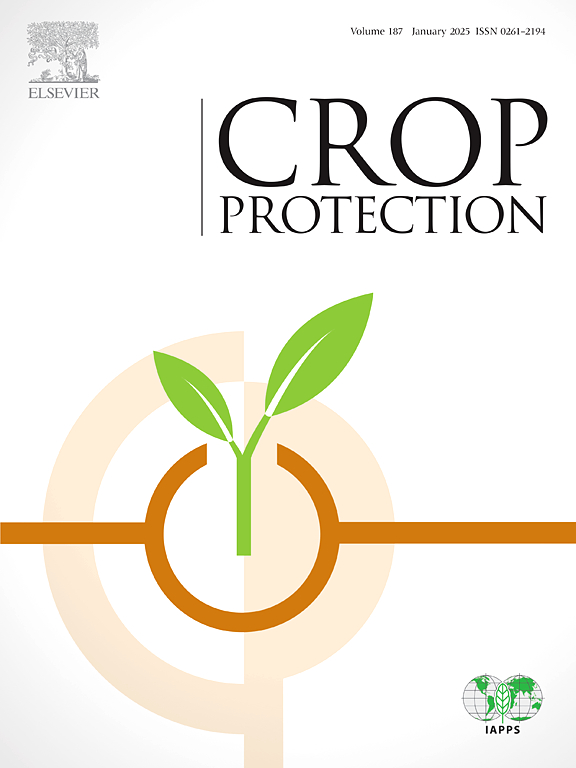基于RPA/CRISPR-cas12a的丁香疫霉快速检测系统的建立
IF 2.5
2区 农林科学
Q1 AGRONOMY
引用次数: 0
摘要
丁香疫霉(Phytophthora syringae),分绿藻真菌门、卵菌门、皮霉门、皮霉科,是城市园林绿化中引起果实褐腐、茎腐、根腐的检疫性病原菌。虽然丁香假单胞菌在中国的存在尚未得到证实。自2011年天津港首次在从美国进口的脐橙上截获丁香假单胞菌以来,各地的检疫部门多次在进口水果中发现疫霉。但传统的形态学鉴定、聚合酶链反应等检测方法耗时长,且对检测人员的专业知识和技术要求较高。本研究建立了重组酶聚合酶扩增(RPA)与CRISPR/Cas12a系统联合鉴定丁香假单胞菌的方法。结果表明,该方法对丁香假单胞菌(P. syringae)具有很高的特异性,而对其他四种主要的柑橘病原菌,包括冬眠假单胞菌(P. hibernalis)、棕榈假单胞菌(P. palmivora)、烟草假单胞菌(P. nicotianae)和柑橘疫霉(P. citrophthora)没有检测到。该方法灵敏度高,可在37℃条件下检测100 pg μL−1丁香假单胞菌基因组DNA,检测时间为45 min。检测结果在紫外线(UV)下可见,并提供荧光团读数。该方法可在自然接种的柑橘果实种子中检测丁香假单胞菌。本研究建立的RPA-CRISPR/Cas12a检测方法具有灵敏度高、效率高、使用方便等特点。早期发现和防治丁香假单胞菌对保护城市绿化物种至关重要。本文章由计算机程序翻译,如有差异,请以英文原文为准。
Establishment of a rapid detection system for Phytophthora syringae based on RPA/CRISPR-cas12a
Phytophthora syringae, classified into algae Eumycophyta, Oomycota, Pythiales, Pythiaceae, which is a quarantine pathogen that causes brown rot on fruits, stem rot and root rot in urban landscaping. Although the existence of P. syringae has not been proven in China. Since the first interception of P. syringae on navel oranges imported from the United States at the port of Tianjin in 2011, quarantine authorities in various locations have repeatedly found Phytophthora in imported fruits. However, traditional detection methods such as morphological identification and polymerase chain reaction are time-consuming and require high levels of expertise and technical requirements for detection personnel. In this study, recombinase polymerase amplification (RPA) in combination with the CRISPR/Cas12a system to identify P. syringae was developed. The assay was found to be highly specific to P. syringae without detection of other tested species including P. hibernalis, P. palmivora, P. nicotianae, and P. citrophthora, four other important pathogens on citrus. And this assay is sensitive and detects 100 pg μL−1 P. syringae genomic DNA at 37 °C in 45 min. The test results were visible under ultraviolet (UV) light and provided a fluorophore readout. This innovative test can detect P. syringae in naturally inoculated citrus fruit seeds. The RPA-CRISPR/Cas12a detection assay developed in this study is characterized by its sensitivity, efficiency and ease of use. Early detection and control of P. syringae are crucial for the protection of urban green cover species.
求助全文
通过发布文献求助,成功后即可免费获取论文全文。
去求助
来源期刊

Crop Protection
农林科学-农艺学
CiteScore
6.10
自引率
3.60%
发文量
200
审稿时长
29 days
期刊介绍:
The Editors of Crop Protection especially welcome papers describing an interdisciplinary approach showing how different control strategies can be integrated into practical pest management programs, covering high and low input agricultural systems worldwide. Crop Protection particularly emphasizes the practical aspects of control in the field and for protected crops, and includes work which may lead in the near future to more effective control. The journal does not duplicate the many existing excellent biological science journals, which deal mainly with the more fundamental aspects of plant pathology, applied zoology and weed science. Crop Protection covers all practical aspects of pest, disease and weed control, including the following topics:
-Abiotic damage-
Agronomic control methods-
Assessment of pest and disease damage-
Molecular methods for the detection and assessment of pests and diseases-
Biological control-
Biorational pesticides-
Control of animal pests of world crops-
Control of diseases of crop plants caused by microorganisms-
Control of weeds and integrated management-
Economic considerations-
Effects of plant growth regulators-
Environmental benefits of reduced pesticide use-
Environmental effects of pesticides-
Epidemiology of pests and diseases in relation to control-
GM Crops, and genetic engineering applications-
Importance and control of postharvest crop losses-
Integrated control-
Interrelationships and compatibility among different control strategies-
Invasive species as they relate to implications for crop protection-
Pesticide application methods-
Pest management-
Phytobiomes for pest and disease control-
Resistance management-
Sampling and monitoring schemes for diseases, nematodes, pests and weeds.
 求助内容:
求助内容: 应助结果提醒方式:
应助结果提醒方式:


